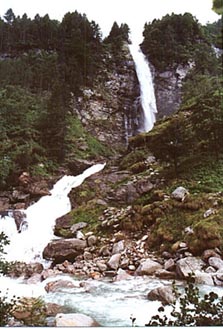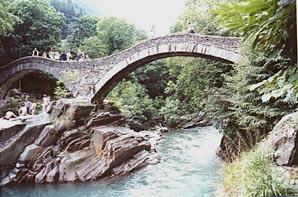
Dear Friends,
Dear Friends,
It is with great pleasure that we introduce the very first issue of our Sneak Preview newsletter. Here, we share information that we have accumulated and invite you to submit some of your own favorite places. We will consider locations anywhere in the world but it must appeal to outdoor enthusiasts. Please tell us what makes it special and if possible, provide local resources to facilitate the planning process for others.
Exploring Ticino, Switzerland

Culture
Bosco Gurin is a Walser settlement that is the only German speaking village in Ticino. Their dialect, Gurin German, is unique and is not understood by other German speaking people. In exchange for military service to the Orelli family, the first residents were granted these lands around 1244 in the remote Bosco Valley, a side valley off the Maggia and Rovana Valleys. Bosco Gurin is a good starting point for day hikes through alpine pastures. There is also a very scenic walk to the nearby village of Cimalmotto (4-5 hrs., easy).
The floor of the Bavona Valley has 12 small villages spread along its 10Km
length. Although each village is distinctive, they are characterized by 300-400 year old
stone buildings called ‘rustici.’ These settlements reflect the ingenious
utilization of a region where less than 2% of available land is arable. Terracing allowed
cultivation of dizzyingly steep valley walls and ‘hanging meadows’ were created
by placing soil on the tops of large boulders. Several rustici have been modernized
inside and are available for rent. Contact the Vallemaggia tourist office for information.
Old Stone Bridges
A number of old, stone bridges can be found throughout the valleys of Ticino. The two-arched bridge at Lavertezzo (Valle Verzasca) is popular among local crowds who take advantage of the huge boulders for sunning on weekends in the summertime. One of the more interesting ways to look at this 16th century bridge is available to scuba divers and snorkelers who can observe the base of the bridge in the river’s crystal clear water as well as the unique rock carvings created by the water. Remember to bring a thick wet suit as the water is very cold. Information is available from the local dive club in Lavertezzo, Tel. 091-746-1691.
Ticino Cuisine
Authentic Ticino cuisine is available at grotti, small, open-air restaurants patronized by locals. Be sure to try their local nostrano wines. Grotti are reasonably priced and are usually located away from urban areas. Two of our favorites are:
Grotto Pozzasc,
6695 Peccia, Tel. 091-755-1604
This little restaurant with simple but delicious Ticinese meals, is located in an old mill
by the Maggia River. At Peccia, follow the left fork in the road with signs to Piano di
Peccia. After crossing the bridge, turn left onto the dirt road near a large building with
granite slabs stacked outside. The restaurant is located about half a mile down the road
and is closed on Mondays and days with poor weather.
Grotto San Michele,
6500 Bellinzona, Tel. 091-826-2353
Grotto San Michele is a charming, open air-restaurant with stone tables and benches in the
shade of a grape arbor. It is operated by Ristorante Castelgrande in the main castle of
Bellinzona. Although not a typical grotto, the food is excellent and the atmosphere
is delightful. There are wonderful views of the city’s old defensive walls with
churches and smaller castles on the hillside.
Landscapes And Our Favorite Hiking Trails
The best way to explore Ticino’s varied landscape is by foot and there are over
2000 Km of well-marked hiking trails. Fortunately, Swiss tourist offices are among the
best in the world and they organize scenic, guided and self-guided tours that appeal to a
wide range of interests. These are coordinated with local transportation (buses, trains,
funicular railway, boats and cable cars) and accommodation possibilities. Here are some of
our favorite day hikes: 
Alpine Meadows - The ‘Strada degli Alpi’ passes through woods and alpine meadows of Val Bedretto. It is one of the most beautiful hikes in Ticino, especially in springtime when flowers are profuse. From just south of Airolo, take the cable car to Pescium and follow the marked trail to Ronco (about 4.5 hrs.). The hike can be shortened by taking the turnoff to the villages of Fontana or Ossasco at Alpe Piano di Pescia. Return by bus to Airolo.
Churches and Chapels - The Ticino river passes through Valle Leventina between Airolo and Biasca. It is a part of an ancient route that connects the Po and Rhine Valleys via the Gottard Pass. The Valle Leventina is noted for its many churches and chapels that were essential stopping places for travelers. Among these are some lovely Romanesque churches located in pretty mountain villages high above the river. Although there are some excellent trails connecting the villages of Alta (Upper) Leventina as well as ruggedly beautiful alpine trails around Lago Ritom (accessed from Piotta), our favorite walk in this valley was a walking tour of the churches and chapels of Giornico in Bassa (Lower) Leventina. Here, the 12th century Church of San Nicolao is the most important Romanesque structure in Ticino. Also interesting are the church and chapel of San Pellegrino that are reached by way of Altirolo, in the hills outside Giornico.
Alpine Lakes - On a clear day, the path around Lago di Robiei and its side trails that ascend to other nearby alpine lakes and the Basodino Glacier is a breathtaking hike with expansive views. These high alpine trails are accessible to day trippers due to the cable car that rises high above the valley from San Carlo in Val Bavona to the Robiei station. Pack a picnic or treat yourself to lunch at Albergo Robiei. For those with more time, use the hotel or the nearby mountain refuge as a base for longer hikes.
Castles - Bellinzona is known as the ‘city of castles’ and is one of Europe’s finest examples of a fortified medieval city. The city was protected by a line of castles and defensive walls that dropped from the upper valley wall to the river. High above the river, Castello di Sasso Corbaro affords an encompassing view of the valley to the north and Lake Maggiore to the south. The old town center, with its narrow cobbled streets and courtyards, is located between Castel Grande and Castello di Montebello. A section of the wall that reached the river was destroyed but the town’s military and commercial importance as the ‘guardian of the passes’ can still be discerned. Although a walking tour of Bellinzona is highly recommended, local buses travel to some of the hillside churches and castles.
Larch Forests and Meadows - A lengthy (7 ½ - 8 hrs.) but rewarding hike begins in Sonogno and ends at Frasco (Val Verzasca). From Sonogno, take the narrow paved road along the Redorta River. On reaching the waterfall, a foot path follows the river to Fraced. Here, the path ascends through a very beautiful larch forest to Alpe di Muggaia and continues through Alpe di Carded up to Corte di Cima before descending to Alpe di Cazzai and Frasco. This is a delightful walk along uncrowded trails. Be sure to wear good hiking boots and take food and water.
Birds - The delta formed by the Ticino River entering Lake Maggiore is a significant wildlife refuge for birds. Over 300 species of European birds nest in the marshland of the Bolle di Magadino, located just beyond the village of Magadino. This is an easy walk for bird watchers and nature lovers along well-marked paths with beautiful views of the mountains beyond the lake.
Resources
Ticino Turismo
PO Box 1441
CH-6501 Bellinzona,
Switzerland
Tel: +41-91-825-7056
Fax: +41-91-825-3614
Email: ett@www.tourism-ticino.ch
The main Ticino Tourist office has travel information and is the best source for brochures
in English which should be requested before leaving home. This web site has general maps
and some enticing photographs as well as contact information for the local tourist
offices.
Ticino Hiking
Via Zurigo 8
CH-6900 Lugano, Switzerland
Tel. & Fax: +41-91-921-3878
Email: ticinohiking@hotmail.com
Ticino Hiking offers some truly off the beaten path tours that emphasize Ticino’s
history and natural wonders. Prices are reasonable and customized trips are available.
Pietro Fabbri and his team of experienced mountain guides share their love of the
mountains and provide an excellent opportunity for exploring Ticino with friends.
Trip Planning Hints
A visit to the local tourist office should be the first stop as local maps, hiking trails, self-guided tours, bus schedules, and lodging information are provided at no charge. However, most brochures are available in German and Italian so English speakers may want to request some information before leaving home.
Detailed maps and hiking guide books are available for sale in bookstores in major cities as well as some of the local tourist offices. There is a limited selection in English.
There are many deals and passes available if you plan to use public transportation in Switzerland. Check with the tourist offices for more information.
An Italian dictionary is very helpful.
Reservations are essential for utilizing alpine huts in summer months, especially on weekends.

© copyright 1999 Adventures Great and Small